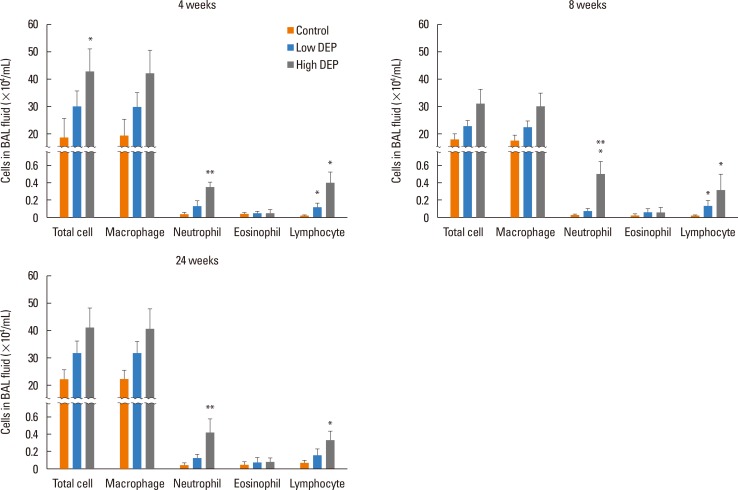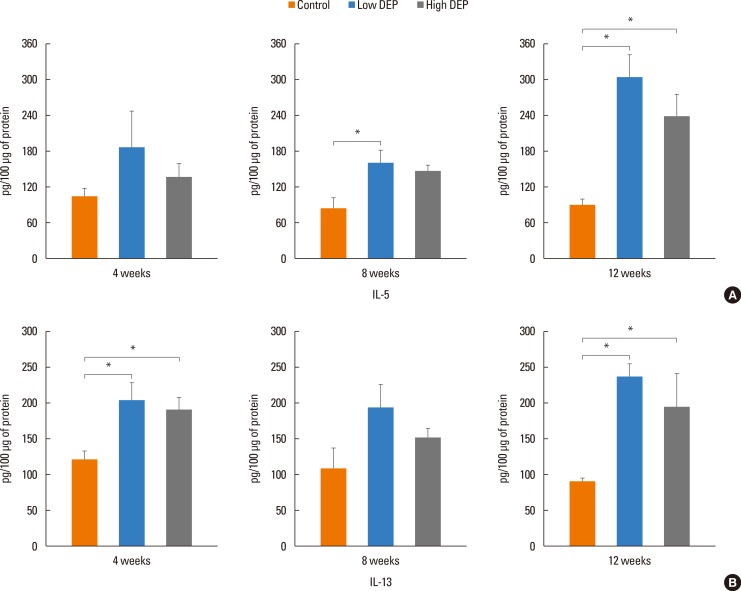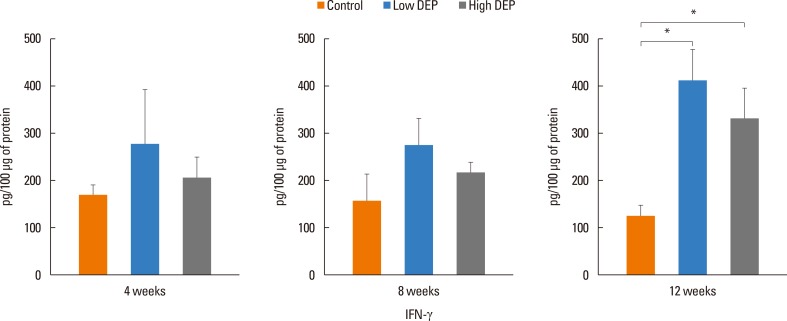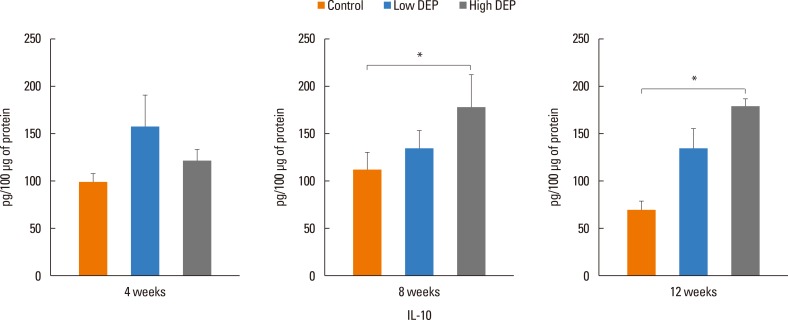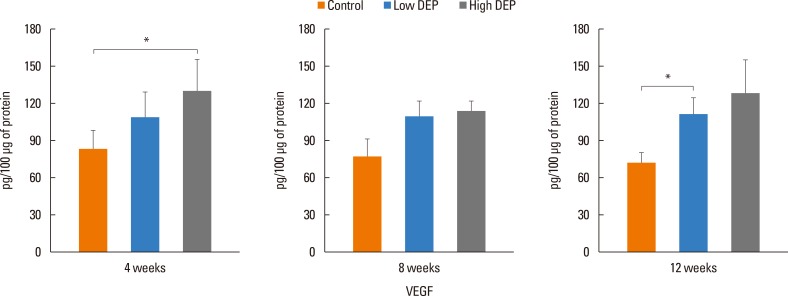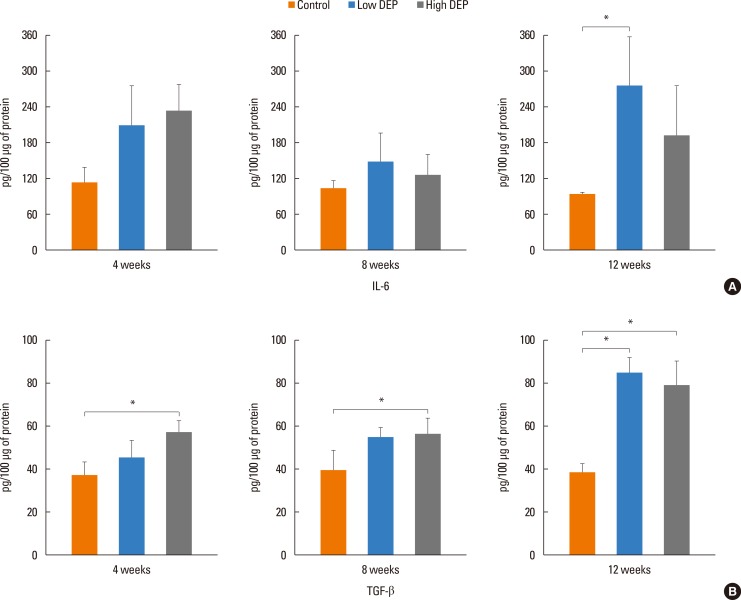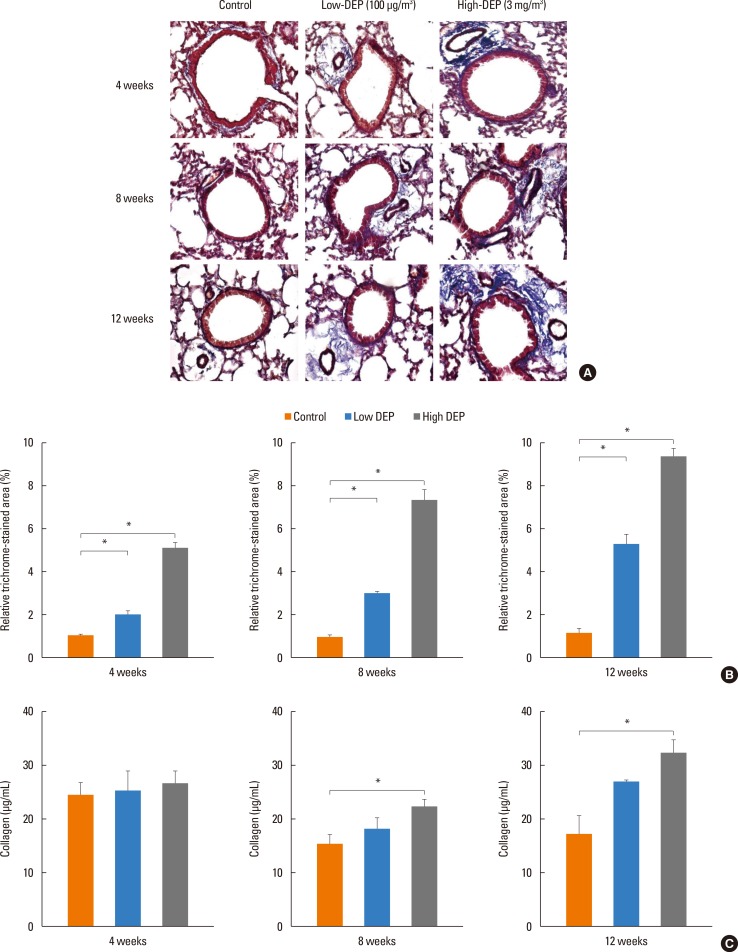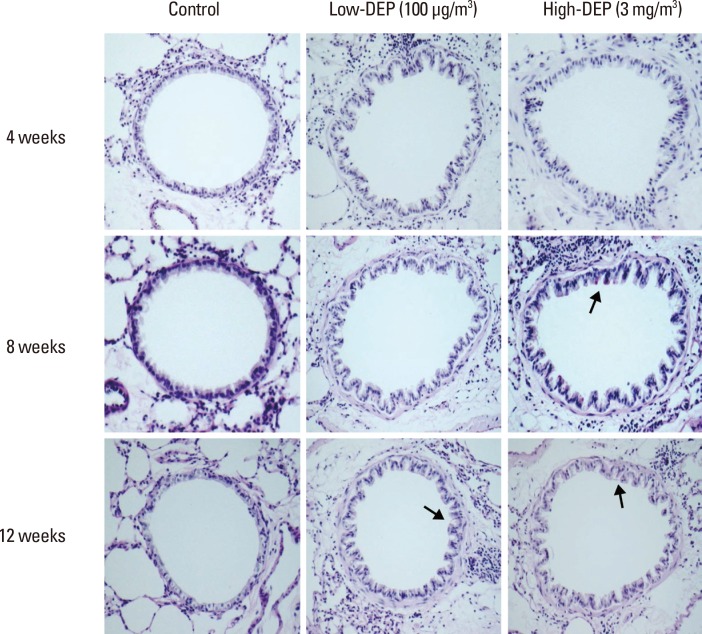Allergy Asthma Immunol Res.
2016 May;8(3):246-256. 10.4168/aair.2016.8.3.246.
Long-Term Effects of Diesel Exhaust Particles on Airway Inflammation and Remodeling in a Mouse Model
- Affiliations
-
- 1Department of Internal Medicine, Soonchunhyang University Bucheon Hospital, Bucheon, Korea. jas877@schmc.ac.kr
- 2Department of Pediatrics, Soonchunhyang University Bucheon Hospital, Bucheon, Korea.
- 3Department of Bioengineering, College of Engineering, Hanyang University, Seoul, Korea.
- KMID: 2391045
- DOI: http://doi.org/10.4168/aair.2016.8.3.246
Abstract
- PURPOSE
Diesel exhaust particles (DEPs) can induce and trigger airway hyperresponsiveness (AHR) and inflammation. The aim of this study was to investigate the effect of long-term DEP exposure on AHR, inflammation, lung fibrosis, and goblet cell hyperplasia in a mouse model.
METHODS
BALB/c mice were exposed to DEPs 1 hour a day for 5 days a week for 3 months in a closed-system chamber attached to a ultrasonic nebulizer (low dose: 100 microg/m3 DEPs, high dose: 3 mg/m3 DEPs). The control group was exposed to saline. Enhanced pause was measured as an indicator of AHR. Animals were subjected to whole-body plethysmography and then sacrificed to determine the performance of bronchoalveolar lavage and histology.
RESULTS
AHR was higher in the DEP group than in the control group, and higher in the high-dose DEP than in the low-dose DEP groups at 4, 8, and 12 weeks. The numbers of neutrophils and lymphocytes were higher in the high-dose DEP group than in the low-dose DEP group and control group at 4, 8, and 12 weeks. The levels of interleukin (IL)-5, IL-13, and interferon-gamma were higher in the low-dose DEP group than in the control group at 12 weeks. The level of IL-10 was higher in the high-dose DEP group than in the control group at 12 weeks. The level of vascular endothelial growth factor was higher in the low-dose and high-dose DEP groups than in the control group at 12 weeks. The level of IL-6 was higher in the low-dose DEP group than in the control group at 12 weeks. The level of transforming growth factor-beta was higher in the high-dose DEP group than in the control group at 4, 8, and 12 weeks. The collagen content and lung fibrosis in lung tissue was higher in the high-dose DEP group at 8 and 12 weeks.
CONCLUSIONS
These results suggest that long-term DEP exposure may increase AHR, inflammation, lung fibrosis, and goblet cell hyperplasia in a mouse model.
Keyword
MeSH Terms
-
Airway Remodeling
Animals
Bronchoalveolar Lavage
Collagen
Fibrosis
Goblet Cells
Hyperplasia
Inflammation*
Interferon-gamma
Interleukin-10
Interleukin-13
Interleukin-6
Interleukins
Lung
Lymphocytes
Mice*
Nebulizers and Vaporizers
Neutrophils
Plethysmography
Pneumonia
Ultrasonics
Vascular Endothelial Growth Factor A
Vehicle Emissions*
Collagen
Interferon-gamma
Interleukin-10
Interleukin-13
Interleukin-6
Interleukins
Vascular Endothelial Growth Factor A
Vehicle Emissions
Figure
Cited by 1 articles
-
Effect of TiO2 Nanoparticles on Inflammasome-Mediated Airway Inflammation and Responsiveness
Byeong-Gon Kim, Pureun-Haneul Lee, Sun-Hye Lee, Moo-Kyun Park, An-Soo Jang
Allergy Asthma Immunol Res. 2017;9(3):257-264. doi: 10.4168/aair.2017.9.3.257.
Reference
-
1. Brandt EB, Biagini Myers JM, Acciani TH, Ryan PH, Sivaprasad U, Ruff B, et al. Exposure to allergen and diesel exhaust particles potentiates secondary allergen-specific memory responses, promoting asthma susceptibility. J Allergy Clin Immunol. 2015; 136:295–303.e7. PMID: 25748065.
Article2. Inoue K, Tanaka M, Takano H. DEP-induced T(H)17 response in asthmatic subjects. J Allergy Clin Immunol. 2014; 133:1495–1496. 1496.e1PMID: 24636096.
Article3. Folinsbee LJ. Human health effects of air pollution. Environ Health Perspect. 1993; 100:45–56. PMID: 8354181.
Article4. Acciani TH, Brandt EB, Khurana Hershey GK, Le Cras TD. Diesel exhaust particle exposure increases severity of allergic asthma in young mice. Clin Exp Allergy. 2013; 43:1406–1418. PMID: 24112543.
Article5. Saito Y, Azuma A, Kudo S, Takizawa H, Sugawara I. Long-term inhalation of diesel exhaust affects cytokine expression in murine lung tissues: comparison between low- and high-dose diesel exhaust exposure. Exp Lung Res. 2002; 28:493–506. PMID: 12217215.
Article6. Dockery DW, Pope CA 3rd, Xu X, Spengler JD, Ware JH, Fay ME, et al. An association between air pollution and mortality in six U.S. cities. N Engl J Med. 1993; 329:1753–1759. PMID: 8179653.
Article7. Samet JM, Dominici F, Curriero FC, Coursac I, Zeger SL. Fine particulate air pollution and mortality in 20 U.S. cities, 1987-1994. N Engl J Med. 2000; 343:1742–1749. PMID: 11114312.
Article8. Hoek G, Brunekreef B, Goldbohm S, Fischer P, van den Brandt PA. Association between mortality and indicators of traffic-related air pollution in the Netherlands: a cohort study. Lancet. 2002; 360:1203–1209. PMID: 12401246.
Article9. Hao M, Comier S, Wang M, Lee JJ, Nel A. Diesel exhaust particles exert acute effects on airway inflammation and function in murine allergen provocation models. J Allergy Clin Immunol. 2003; 112:905–914. PMID: 14610479.
Article10. Pope CA, Dockery DW, Schwartz J. Review of epidemiological evidence of health effects of particulate air pollution. Inhal Toxicol. 1995; 7:1–18.
Article11. Morgan WK, Reger RB, Tucker DM. Health effects of diesel emissions. Ann Occup Hyg. 1997; 41:643–658. PMID: 9375524.
Article12. Ishihara Y, Kagawa J. Chronic diesel exhaust exposures of rats demonstrate concentration and time-dependent effects on pulmonary inflammation. Inhal Toxicol. 2003; 15:473–492. PMID: 12682859.
Article13. Ghio AJ, Smith CB, Madden MC. Diesel exhaust particles and airway inflammation. Curr Opin Pulm Med. 2012; 18:144–150. PMID: 22234273.
Article14. Royce SG, Moodley Y, Samuel CS. Novel therapeutic strategies for lung disorders associated with airway remodelling and fibrosis. Pharmacol Ther. 2014; 141:250–260. PMID: 24513131.
Article15. van den Brûle S, Heymans J, Havaux X, Renauld JC, Lison D, Huaux F, et al. Profibrotic effect of IL-9 overexpression in a model of airway remodeling. Am J Respir Cell Mol Biol. 2007; 37:202–209. PMID: 17446528.
Article16. Henderson WR Jr, Chi EY, Bollinger JG, Tien YT, Ye X, Castelli L, et al. Importance of group X-secreted phospholipase A2 in allergen-induced airway inflammation and remodeling in a mouse asthma model. J Exp Med. 2007; 204:865–877. PMID: 17403936.
Article17. Kunzmann S, Schmidt-Weber C, Zingg JM, Azzi A, Kramer BW, Blaser K, et al. Connective tissue growth factor expression is regulated by histamine in lung fibroblasts: potential role of histamine in airway remodeling. J Allergy Clin Immunol. 2007; 119:1398–1407. PMID: 17412405.
Article18. Sydbom A, Blomberg A, Parnia S, Stenfors N, Sandström T, Dahlén SE. Health effects of diesel exhaust emissions. Eur Respir J. 2001; 17:733–746. PMID: 11401072.
Article19. Andersen AA. A sampler for respiratory health hazard assessment. Am Ind Hyg Assoc J. 1966; 27:160–165. PMID: 5954000.
Article20. Song HM, Jang AS, Ahn MH, Takizawa H, Lee SH, Kwon JH, et al. Ym1 and Ym2 expression in a mouse model exposed to diesel exhaust particles. Environ Toxicol. 2008; 23:110–116. PMID: 18214922.
Article21. Lee GB, Brandt EB, Xiao C, Gibson AM, Le Cras TD, Brown LA, et al. Diesel exhaust particles induce cysteine oxidation and s-glutathionylation in house dust mite induced murine asthma. PLoS One. 2013; 8:e60632. PMID: 23555996.
Article22. Kim J, Natarajan S, Vaickus LJ, Bouchard JC, Beal D, Cruikshank WW, et al. Diesel exhaust particulates exacerbate asthma-like inflammation by increasing CXC chemokines. Am J Pathol. 2011; 179:2730–2739. PMID: 21967814.
Article23. Grünig G, Warnock M, Wakil AE, Venkayya R, Brombacher F, Rennick DM, et al. Requirement for IL-13 independently of IL-4 in experimental asthma. Science. 1998; 282:2261–2263. PMID: 9856950.
Article24. Hamelmann E, Schwarze J, Takeda K, Oshiba A, Larsen GL, Irvin CG, et al. Noninvasive measurement of airway responsiveness in allergic mice using barometric plethysmography. Am J Respir Crit Care Med. 1997; 156:766–775. PMID: 9309991.
Article25. Diaz-Sanchez D, Proietti L, Polosa R. Diesel fumes and the rising prevalence of atopy: an urban legend? Curr Allergy Asthma Rep. 2003; 3:146–152. PMID: 12562554.
Article26. Jung DY, Leem JH, Kim HC, Kim JH, Hwang SS, Lee JY, et al. Effect of traffic-related air pollution on allergic disease: results of the children's health and environmental research. Allergy Asthma Immunol Res. 2015; 7:359–366. PMID: 25936911.
Article27. Lee JH, Lee HS, Park MR, Lee SW, Kim EH, Cho JB, et al. Relationship between indoor air pollutant levels and residential environment in children with atopic dermatitis. Allergy Asthma Immunol Res. 2014; 6:517–524. PMID: 25374751.
Article28. Nel AE, Diaz-Sanchez D, Ng D, Hiura T, Saxon A. Enhancement of allergic inflammation by the interaction between diesel exhaust particles and the immune system. J Allergy Clin Immunol. 1998; 102:539–554. PMID: 9802360.
Article29. Takahashi G, Tanaka H, Wakahara K, Nasu R, Hashimoto M, Miyoshi K, et al. Effect of diesel exhaust particles on house dust mite-induced airway eosinophilic inflammation and remodeling in mice. J Pharmacol Sci. 2010; 112:192–202. PMID: 20093792.
Article30. Takano H, Ichinose T, Miyabara Y, Yoshikawa T, Sagai M. Diesel exhaust particles enhance airway responsiveness following allergen exposure in mice. Immunopharmacol Immunotoxicol. 1998; 20:329–336. PMID: 9653676.
Article31. Ohta K, Yamashita N, Tajima M, Miyasaka T, Nakano J, Nakajima M, et al. Diesel exhaust particulate induces airway hyperresponsiveness in a murine model: essential role of GM-CSF. J Allergy Clin Immunol. 1999; 104:1024–1030. PMID: 10550748.
Article32. Ichinose T, Takano H, Miyabara Y, Sadakaneo K, Sagai M, Shibamoto T. Enhancement of antigen-induced eosinophilic inflammation in the airways of mast-cell deficient mice by diesel exhaust particles. Toxicology. 2002; 180:293–301. PMID: 12393297.
Article33. Walters DM, Breysse PN, Wills-Karp M. Ambient urban Baltimore particulate-induced airway hyperresponsiveness and inflammation in mice. Am J Respir Crit Care Med. 2001; 164:1438–1443. PMID: 11704592.
Article34. Miyabara Y, Ichinose T, Takano H, Lim HB, Sagai M. Effects of diesel exhaust on allergic airway inflammation in mice. J Allergy Clin Immunol. 1998; 102:805–812. PMID: 9819298.
Article35. Lim HB, Ichinose T, Miyabara Y, Takano H, Kumagai Y, Shimojyo N, et al. Involvement of superoxide and nitric oxide on airway inflammation and hyperresponsiveness induced by diesel exhaust particles in mice. Free Radic Biol Med. 1998; 25:635–644. PMID: 9801062.
Article36. Takano H, Yoshikawa T, Ichinose T, Miyabara Y, Imaoka K, Sagai M. Diesel exhaust particles enhance antigen-induced airway inflammation and local cytokine expression in mice. Am J Respir Crit Care Med. 1997; 156:36–42. PMID: 9230723.
Article37. Monforton C. Weight of the evidence or wait for the evidence? Protecting underground miners from diesel particulate matter. Am J Public Health. 2006; 96:271–276. PMID: 16380560.
Article38. Bonner JC. Lung fibrotic responses to particle exposure. Toxicol Pathol. 2007; 35:148–153. PMID: 17325983.
Article39. Riedl M, Diaz-Sanchez D. Biology of diesel exhaust effects on respiratory function. J Allergy Clin Immunol. 2005; 115:221–228. PMID: 15696072.
Article40. Ackland ML, Zou L, Freestone D, van de Waasenburg S, Michalczyk AA. Diesel exhaust particulate matter induces multinucleate cells and zinc transporter-dependent apoptosis in human airway cells. Immunol Cell Biol. 2007; 85:617–622. PMID: 17680010.
Article41. Cao D, Bromberg PA, Samet JM. COX-2 expression induced by diesel particles involves chromatin modification and degradation of HDAC1. Am J Respir Cell Mol Biol. 2007; 37:232–239. PMID: 17395887.
Article42. Mamessier E, Nieves A, Vervloet D, Magnan A. Diesel exhaust particles enhance T-cell activation in severe asthmatics. Allergy. 2006; 61:581–588. PMID: 16629788.
Article43. Porter M, Karp M, Killedar S, Bauer SM, Guo J, Williams D, et al. Diesel-enriched particulate matter functionally activates human dendritic cells. Am J Respir Cell Mol Biol. 2007; 37:706–719. PMID: 17630318.
Article44. Chan RC, Wang M, Li N, Yanagawa Y, Onoé K, Lee JJ, et al. Pro-oxidative diesel exhaust particle chemicals inhibit LPS-induced dendritic cell responses involved in T-helper differentiation. J Allergy Clin Immunol. 2006; 118:455–465. PMID: 16890772.
Article45. Bleck B, Tse DB, Jaspers I, Curotto de Lafaille MA, Reibman J. Diesel exhaust particle-exposed human bronchial epithelial cells induce dendritic cell maturation. J Immunol. 2006; 176:7431–7437. PMID: 16751388.
Article46. Kang CM, Jang AS, Ahn MH, Shin JA, Kim JH, Choi YS, et al. Interleukin-25 and interleukin-13 production by alveolar macrophages in response to particles. Am J Respir Cell Mol Biol. 2005; 33:290–296. PMID: 15961726.
Article
- Full Text Links
- Actions
-
Cited
- CITED
-
- Close
- Share
- Similar articles
-
- Comment on "Long-Term Effects of Diesel Exhaust Particles on Airway Inflammation and Remodeling in a Mouse Model" by Kim et al.
- Increase of diesel car raises health risk in spite of recent development in engine technology
- Diesel Exhaust Particles and Asthma
- Effects of Diesel Exhaust Particles on Airway Inflammation and Hyperresponsiveness in a Murine Model
- Additive Effect of Diesel Exhaust Particulates and Ozone on Airway Hyperresponsiveness and Inflammation in a Mouse Model of Asthma



